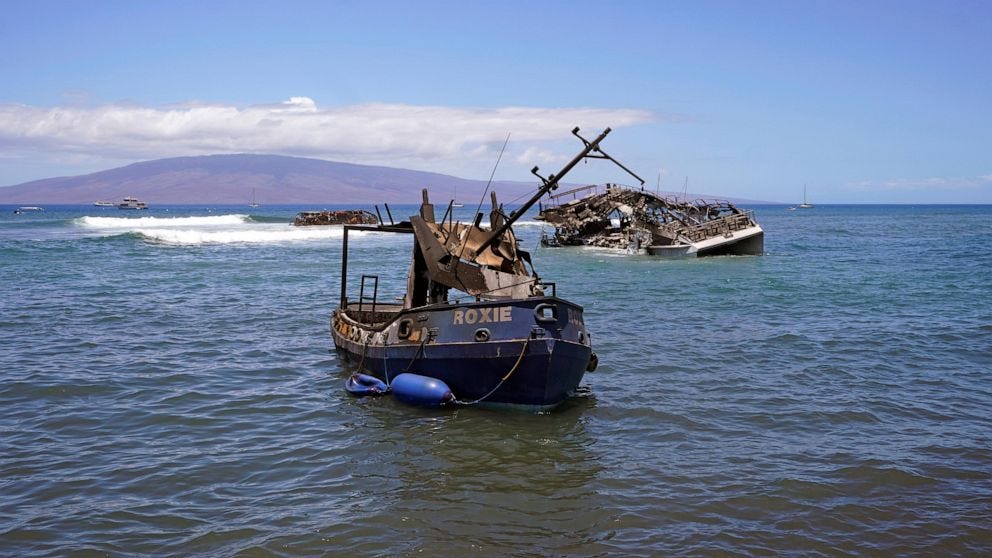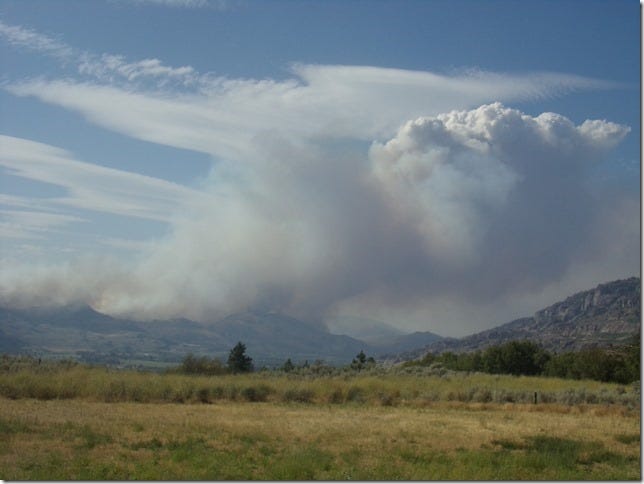Questioning Discrepancies I Found About Lahaina Weather. Open To All Input
Being familiar with how humidity affects wildfires, I was curious about Lahaina and found many questions to be answered.
(AP Photo/Rick Bowmer) The Lahaina fire was so hot it burned boats offshore. Yet left green trees next to houses that were reduced to powder?
A wildfire that burned so hot it left molten metal?
Living in Northeast Washington, where our precipitation averaging 12.3” per year classifies us as desert, wild fires are an expected yearly occurrence. The ferocity of the wildfire in Lahaina , Hawaii, with actual molten metal in the street intrigued me. With unburned grasses and trees nearby! In my time here, I have seen 100 acres burn in minutes. I have seen 70’ trees explode in flames like a big match stick. I have even seen “firenadoes”, which I spoke of in a previous essay and linked a YouTube video. But I have NEVER seen or heard of anyone in Washington seeing molten metal at a fire incident!
The relationship between humidity levels and controlled burns
Fire isn’t going to occur until the moisture content in the fuel reaches the point where there’s enough net energy coming from the heat source. Once the heat has evaporated enough water, the fuel will burn,
If humidity is very high, fire isn’t going to do much because the heat has to burn off moisture in the air to ignite the fuel, - NC State professor Joseph Roise, who studies wildland fire behavior and prevention
The ideal relative humidity range for burning is between 30 and 50 percent. Fires are difficult to control when the relative humidity falls below 30 percent. A relative humidity higher than 50 percent may be appropriate in some circumstances but may not accomplish your objectives in other situations.
Fire Weather Criteria according to the NOAA National Weather Service
RED FLAG CRITERIA. Red flag events normally require the combination of critical fuel conditions and critical weather conditions. Several combinations of fuels and weather conditions may combine to produce red flag conditions. Fuel conditions are considered critical when fuel characteristics are favorable for large fire growth, as determined by the land management agencies. NWS forecasters determine when weather conditions are critical.
A. Primary Red Flag Criteria:
1) Relative humidity of 15% or less combined with sustained surface winds, or frequent gusts, of 25 mph or greater. Both conditions must occur simultaneously for at least 3 hours in a 12 hour period.
2) Widely scattered (or more) dry thunderstorms, 15% or more coverage, constituting a Lightning Activity Level (LAL) 6. A thunderstorm is considered “dry” if it produces less than 0.10 inch rainfall.
B. Contributing Red Flag Factors:
1) First significant lightning occurrence after a hot and dry period. This includes “wet” or “dry” thunderstorms, widely scattered (15%) coverage or more. After a hot and dry period, the first occurrence of thunderstorms can readily start wildfires. The RH does not need to meet the criteria listed above.
2) Significant cold frontal passage, expected to cause strong sustained and gusty winds, and an abrupt wind shift. Of heightened concern are dry cold fronts that have the above characteristics, but little or no rainfall, and expected when there are on-going wildfires or prescribed burns. The RH does not need to meet the criteria listed above.
3) Any combination of weather and fuels conditions that would create a critical fire control situation or extensive wildfire outbreak. These may include: long term drought, much higher than normal maximum temperatures coupled with very low humidity, low fuel moisture, poor nighttime RH recovery, high Energy Release Component (ERC) or Burning Index (BI), a Haines Index of 5 or 6, etc.
What were weather conditions and the humidity level in Lahaina, Hawaii on August 8, 2023?
In a timeline from an ABC News article:
By 11 a.m., firefighting crews from several towns and the Hawaii Department of Lands had converged on the Upcountry fire, but wind gusts reaching 80 mph (129 kph) made conditions unsafe for helicopters. At 3:20 p.m., more Upcountry neighborhoods were evacuated.
However, when I pulled up weather records from weatherspark.com for Lahaina on August 8, the highest wind recorded was 41.4 MPH at 2:54 AM! The highest during the day was 40 MPH! In a video I watched that I will include further down, an electric company representative said they did not shut down power because wind speed never came near the 65 MPH shutdown speed. Yet, they are already trying to hang this disaster around the electric company's neck as in California! Weatherspark.com gives dew points. From 6 AM to 6PM it was in the 65° F to 75° F muggy range. The temperature was 78.1°F at 5:54 AM and 82°F at 5:54 PM with a high of 87.1°F at 1:54 PM.
the relative humidity is determined by how close the air temperature is to the dew point temperature. The closer these values are, the higher the humidity. The further apart these values are, the lower the humidity.
From WU underground.com, which when you ask for Lahaina weather for August 8, switches you to Kahluli Airport weather station, 16 miles away, I was able to get actual humidity, the lowest being 51% at 10:54 AM. The rest of the day the highest at 74% with a good portion in the high 60% range. Hardly favorable for such a fierce fire. The highest wind speed even lower at 30 MPH.
Temperature at Kahluli Airport weather station at 8:54 AM was 0° F. Talk amongst yourselves
I'm just reporting what the record says. At 7:54 AM it was 81° F and at 9:54 AM it was 82° F. Equipment malfunction or something else? Also, when you enter the link in your search browser, this is what comes up under the August 8 search:
WebAug 8, 2023 · Thank you for reporting this station. We will review the data in question. You are about to report this weather station for bad data. Please select the …
You are still able to click the link and see the data, (so far).
Realtor, Eric West, shares science defying videos
Eric lives on Maui and is documenting the incredible circumstances. The above image starting the video showed two cars with the wheels and engine blocks melted all over the place in the center of unburned grass right in the middle of totally undamaged homes.
In the second video, another totally destroyed and melted car in the middle of more unburned grass. With the addition of multiple police ordered to keep people out of the burned areas. What are they hiding?
Eric also shared that realtors are not approaching people to sell their properties but are turning down buyers who are looking to cash in on the misfortune of property owners. He is also taking donations. 100% to go to people victimized by the unusual fire.
In conclusion
I had some questions about the humidity levels and other conditions necessary to cause such a raging fire with so many unexplainable results and found a lot more. As I said previously, is an extermination event coming to a neighborhood near you?






I've been mostly quiet about this, though I remind my readers about it occasionally, but now I am starting to wonder if the "authorities" are lying about the death count. And clearly no one is being held accountable for this.
I want to know when murder charges occur on the Chief of Police, every police in duty that day, the mayor and the governor. The military will say "national security" reasons why they cannot explain their use of DEWs. Yeah, heads need to roll.